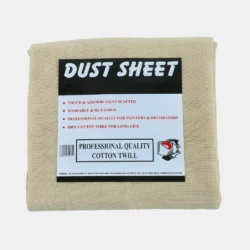-
Standard Cotton Dust Sheets
Standard Cotton Dust Sheets – 12’x9′
£7.74 – £473.23 Select options This product has multiple variants. The options may be chosen on the product page
Conquering the Cover-Up: Choosing the Perfect Size Cotton Dust Sheet in the UK
Ah, the humble cotton dust sheet. A DIY warrior’s best friend, a decorator’s dream, and a lifesaver for furniture during that springtime spruce-up. But with a multitude of sizes available in UK stores, picking the right one can feel like navigating a labyrinth. Fear not, fellow home improver! This guide will equip you to select the perfect cotton dust sheet size for any project, ensuring your floors and furniture are protected from dust, debris, and those inevitable paint splatters.
Sizing Up Your Needs: Common Cotton Dust Sheet Sizes in the UK
Cotton dust sheets come in a range of widths and lengths, typically measured in feet (ft) or metres (m). Here’s a breakdown of some of the most commonly found sizes in UK retailers:
- Small (3ft x 6ft or 1m x 1.8m): Ideal for protecting individual items like chairs, small tables, or appliances. Perfect for tight spaces or craft projects.
- Medium (6ft x 9ft or 1.8m x 2.7m): A versatile size, suitable for covering medium-sized furniture like sofas, armchairs, or protecting floors while painting a small room.
- Large (9ft x 12ft or 2.7m x 3.6m): A popular choice for protecting large furniture pieces like beds, dining tables, or covering extensive floor areas during renovations.
- Extra Large (12ft x 12ft or 3.6m x 3.6m): For grand projects! Ideal for covering expansive rooms, shielding multiple furniture pieces, or creating a dust barrier in larger hallways.
- Staircase Sheets (typically 3ft x 24ft or 1m x 7.3m): A lifesaver when painting or decorating staircases. These long, narrow sheets protect both treads and risers.
Top Tip: When in doubt, opt for a slightly larger size than you initially think you need. It’s always better to have excess material you can fold or tuck under for a secure fit, rather than a sheet that leaves precious furniture exposed.
Matching the Sheet to the Situation: Choosing Your Perfect Size
Now that you know the usual suspects, let’s delve into selecting the ideal size for your specific project:
- Protecting Furniture: Measure the length, width, and height of the furniture you want to cover. Add a couple of feet to each dimension for tucking and overhang. For example, to protect a 3-seater sofa that’s 6ft long, a 6ft x 9ft sheet would be suitable.
- Covering Floors: Measure the floor area you want to protect. Consider the placement of furniture and allow for some extra material to go up skirting boards. If you’re unsure about room measurements, most hardware stores offer measuring tools for rent.
- Shielding Multiple Items: If you’re protecting a collection of furniture in a single room, consider the overall layout. A larger sheet, like a 12ft x 12ft, might be more efficient than multiple smaller ones, especially if you can drape it over furniture pieces creatively.
Beyond the Basics: Additional Factors to Consider
While size is king, there are a few other things to keep in mind when choosing your cotton dust sheet:
- Material Weight: Cotton dust sheets come in different weights, typically measured in ounces (oz) per square yard. A heavier weight (like 10oz or 12oz) offers better durability and tear resistance, ideal for heavy-duty projects or frequent use.
- Drop Cloths vs Dust Sheets: Drop cloths are similar to dust sheets but are often made from a thicker canvas material. They’re perfect for catching spills and drips, making them ideal for heavy-duty painting or decorating jobs.
- Washability: Look for pre-washed cotton dust sheets, which are softer and less likely to shrink. Most cotton dust sheets are machine washable, allowing for easy cleaning and reuse.
The Final Fit: Tips for Using Your Cotton Dust Sheet Effectively
Once you’ve got your perfectly sized sheet, here are some pro tips to ensure it does its job flawlessly:
- Secure the Sheet: Use painter’s tape or masking tape to secure the edges of the sheet to skirting boards or baseboards to prevent dust from creeping underneath.
- Fold and Drape: Don’t be afraid to fold or drape the sheet to create a snug fit around furniture legs or awkward corners.
- Double Up for Extra Protection: For high-dust projects or when using messy materials, consider using two dust sheets layered on top.




